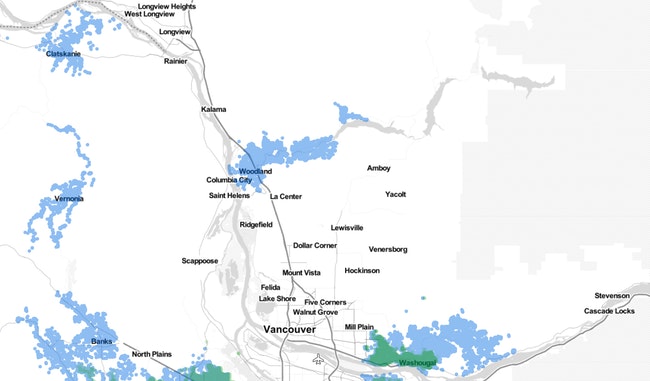 Ziply’s current broadband network in northwest Oregon. Blue is broadband, green is fiber. Photo courtesy Ziply website
Ziply’s current broadband network in northwest Oregon. Blue is broadband, green is fiber. Photo courtesy Ziply website
The rural portions of Washington County have always struggled to gain access to high speed internet, with some regions solely relying on satellite or microwave options, while others are on copper lines now owned by Ziply Fiber, which acquired the former network of the struggling Frontier Communications operation in Oregon, Washington, Idaho and Montana on May 1 of this year.
Now, with a global pandemic forcing students to learn at home and many adults to work online from home, a reliable network has suddenly become even more important.
The Frontier network for rural residents in far western Washington County has been a constant source of frustration for years, with technical issues plaguing the aging network and often poor customer service being a hallmark of their legacy. With the acquisition of the network by Ziply, a new company, is there a future in western Washington County where internet connectivity comes in the way of fiber instead of copper? Perhaps, says the company.
While a spokesperson for the company told the Gales Creek Journal in early August that there was no update on if the company would be tackling any projects in the region soon, Brian Stading, Ziply’s Chief Operating Officer, told the Journal that the company plans to add fiber options to about 85% of their customer base over the next few years. Currently, roughly 30% of Ziply customers have access to fiber, according to the company.
 We rely on subscribers to keep the lights on at the Gales Creek Journal. Support us with a digital subscription: Click here to start
We rely on subscribers to keep the lights on at the Gales Creek Journal. Support us with a digital subscription: Click here to start
It remains to be seen whether residents in rural western Washington County will be in that 85%.
At its most basic, fiber-optic communication sends information via pulses of infrared light through fiber-optic cables, and generally provides superior speed over longer distances than the older copper technology when it comes to high speed internet.
“Building fiber internet in places where it’s never been before is an inherently challenging and time-consuming process, but we’re really excited to be doing it for communities that have been underserved for so long,” Stading said in an email to the Journal.
“No two projects are the same,” he said. “Each takes several months to complete, even if we move as quickly as possible. There’s a lot to do in every sequence. We have to plan, secure permits, procure new equipment and thousands of miles of fiber-optic cables, hire and schedule crews to run the fiber, set up the Central Office where our equipment will be housed, and install fiber connections in individual homes and businesses – that’s just the big stuff. If the majority of the work is aerial, where we can lash fiber to the existing copper phone lines, that speeds things up. If work is underground intensive, or weather hampers our activity, it takes more time.”
In May of this year, the company announced that it was starting 13 projects to bring fiber to areas that largely did not have existing fiber options; in Oregon, that included Coquille, Coos Bay, La Grande, and North Bend.
Stading said that it makes the most sense to leave existing copper lines in place and add fiber alongside them, as the older copper technology still has use for other purposes.
Stading cited several challenges in building out fiber to a rural area, one of the largest being the sheer distance needed to cover a less densely populated area.
“When you increase the distance from an established fiber network site, Central Office or remote access point to a new area, the longer that distance is from Point A to Point B, the more likely it is you’ll encounter obstacles along the way,” he explained. The longer a line, the more time, energy and cost is required to build, but Stading said building out their network’s capacity is work that Ziply is prepared for.
Another challenge, he noted, is the permitting process, which can see delays when working with local municipalities and existing utility providers while securing permits. He said his company’s local knowledge was a strength in dealing with the legalities of building physical infrastructure.
 Brian Stading. Photo: Ziply Fiber
Brian Stading. Photo: Ziply Fiber
“As a local, Northwest-based company, we pride ourselves on being easy to work with and we go into each community confident in our ability to work well and work productively with every city, town and neighborhood,” said Stading.
He also gave three points he believes set Ziply apart from competition as they build out their newer part of the network; a dedication to a “consistently on” network thanks to redundant infrastructure; a network that has consistent speeds, citing a plan to build new capacity when any piece of network or equipment hits 30% use and keep capacity at no more than 40% on any one part of the network; and a confidence that their network can tackle anything a customer wants to access online, with direct peering to what he said were “hundreds of the top content providers – including top streaming services, online retailers, and social networks,” which means a customer can access those sites more quickly.
“The challenges with the network we inherited from Frontier are many,” said Stading.
Ziply plans to spend more than $500 million in improvements on the network, he said, and noted that the process of taking over from Frontier was made easier by an experienced team and work done prior to the official sale date.
“While every Central Office and piece of equipment we inherited has its own nuanced set of challenges, we’re busy building a new, fully redundant network with 10 times the capacity of the one we’ve acquired. We are fully committed to delivering fast, reliable fiber internet, and a refreshingly great customer experience for everyone in Oregon, Washington, Idaho and Montana,” Stading said.

Chas Hundley is the editor of the Gales Creek Journal and sister news publications the Banks Post and the Salmonberry Magazine. He grew up in Gales Creek and has a cat.






